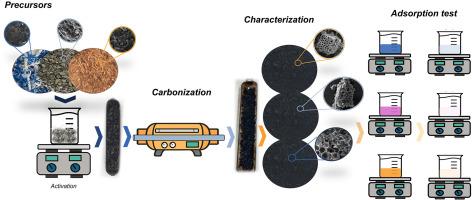工业残渣可持续活性炭:将污水污泥、生物质和聚合物转化为高性能吸附剂
IF 5.8
2区 生物学
Q1 AGRICULTURAL ENGINEERING
引用次数: 0
摘要
对可持续残留物管理日益增长的需求鼓励了将工业、农业和聚合物废物转化为高价值材料的工艺的发展。本研究报道了木质纤维素残渣(LR)、工业污水污泥(SSR)和含聚合物混合物(Mix)通过磷酸化学活化生产活性炭(ACs)。系统考察了前驱体类型和酸浓度对活性炭理化性能和吸附性能的影响。制备的活性炭具有高表面积(高达960 m2 g−1)、发育良好的微孔/介孔结构和丰富的含氧官能团等特点。亚甲基蓝(MB)、罗丹明B (RhB)和甲基橙(MO)对ACLR3 (MB为384 mg g−1)和ACSSR3 (MB为349 mg g−1,MO为101 mg g−1)的吸附实验显示出优异的吸附能力。在连续活化循环中重复使用磷酸的可行性也得到了证明,ACSSR3在第一次重复使用时保持了良好的表面性能和吸附性能。这些发现验证了活性炭生产的循环策略,该策略可以最大限度地减少化学品消耗和废物产生,同时提供有效的废水处理和环境修复材料。本文章由计算机程序翻译,如有差异,请以英文原文为准。

Sustainable activated carbon from industrial residue: Transforming sewage sludge, biomass, and polymers into high-performance adsorbents
The growing demand for sustainable residue management has encouraged the development of processes to convert industrial, agricultural, and polymeric wastes into high-value materials. This study reports the production of activated carbons (ACs) from lignocellulosic residue (LR), industrial sewage sludge (SSR), and a polymer-containing mixture (Mix) via chemical activation with phosphoric acid. The effects of precursor type and acid concentration on the physicochemical properties and adsorption performance of ACs were systematically evaluated. The produced ACs exhibited high surface areas (up to 960 m2 g−1), well-developed micro/mesoporous structures, and abundant oxygenated functional groups. Adsorption experiments with methylene blue (MB), rhodamine B (RhB), and methyl orange (MO) revealed outstanding capacities, particularly for ACLR3 (384 mg g−1 for MB) and ACSSR3 (349 mg g−1 for MB and 101 mg g−1 for MO). The feasibility of reusing phosphoric acid in successive activation cycles was also demonstrated, with ACSSR3 maintaining excellent surface properties and adsorption performance in the first reuse. These findings validate a circular strategy for activated carbon production that minimizes chemical consumption and waste generation while delivering effective wastewater treatment and environmental remediation materials.
求助全文
通过发布文献求助,成功后即可免费获取论文全文。
去求助
来源期刊

Biomass & Bioenergy
工程技术-能源与燃料
CiteScore
11.50
自引率
3.30%
发文量
258
审稿时长
60 days
期刊介绍:
Biomass & Bioenergy is an international journal publishing original research papers and short communications, review articles and case studies on biological resources, chemical and biological processes, and biomass products for new renewable sources of energy and materials.
The scope of the journal extends to the environmental, management and economic aspects of biomass and bioenergy.
Key areas covered by the journal:
• Biomass: sources, energy crop production processes, genetic improvements, composition. Please note that research on these biomass subjects must be linked directly to bioenergy generation.
• Biological Residues: residues/rests from agricultural production, forestry and plantations (palm, sugar etc), processing industries, and municipal sources (MSW). Papers on the use of biomass residues through innovative processes/technological novelty and/or consideration of feedstock/system sustainability (or unsustainability) are welcomed. However waste treatment processes and pollution control or mitigation which are only tangentially related to bioenergy are not in the scope of the journal, as they are more suited to publications in the environmental arena. Papers that describe conventional waste streams (ie well described in existing literature) that do not empirically address ''new'' added value from the process are not suitable for submission to the journal.
• Bioenergy Processes: fermentations, thermochemical conversions, liquid and gaseous fuels, and petrochemical substitutes
• Bioenergy Utilization: direct combustion, gasification, electricity production, chemical processes, and by-product remediation
• Biomass and the Environment: carbon cycle, the net energy efficiency of bioenergy systems, assessment of sustainability, and biodiversity issues.
 求助内容:
求助内容: 应助结果提醒方式:
应助结果提醒方式:


